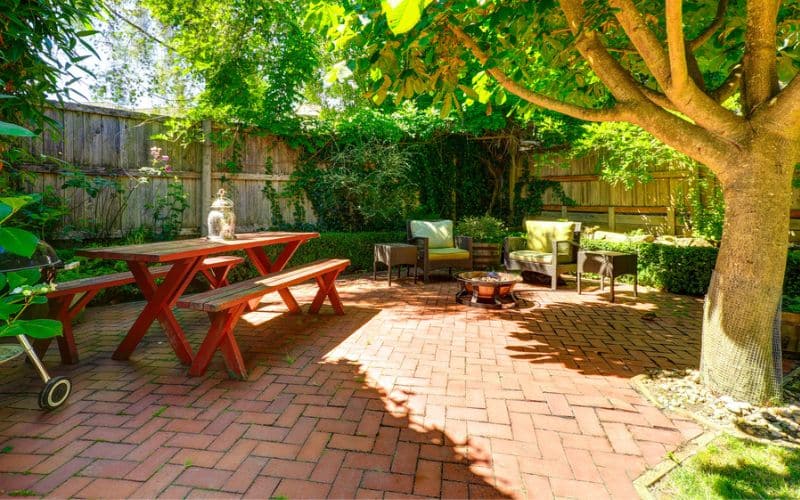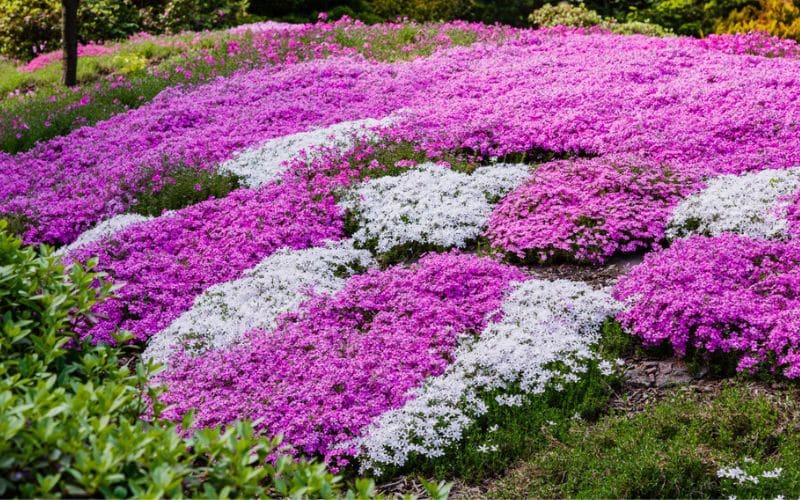
The outdoor space surrounding tree trunks is often overlooked, leading to exposed roots, bare soil, and stray weeds. This is due to the tree’s roots absorbing water and the heavy branches blocking sunlight, making it difficult for other plants to grow in the garden around the tree. Traditionally, the area around a tree was landscaped using brick, stone, or rubber. However, there are many creative ways to landscape around an existing tree to enhance its natural beauty while maintaining its health.
From planting simple flower beds to constructing an entire deck around a stunning tree, numerous ideas and designs cater to various challenges. These solutions aim to transform and elevate the areas around tree trunks, creating a healthy and harmonious garden around the tree.
Are Exposed Tree’s Roots Bad For My Tree?
Tree roots that are exposed can put the tree at risk when they come into contact with the cutting edges of a mower. As a result of the damaged roots, the tree may develop susceptibility to diseases through open wounds. Exposed roots can also hinder the growth of grass, create a tripping hazard, and potentially cause structures to be lifted.
Best Ideas For Landscaping Around Trees
If you’re aiming to enhance the tree’s beauty, be it around large trees, mature trees, or simply adding color to potted trees, there is no shortage of ideas for landscaping around them. Here are our top suggestions for improving the area surrounding trees.
Grow A Shade Garden
You might have previously hesitated to adorn your tree’s trunk with vibrant flowers, fearing the shade would undermine your efforts. However, it’s time to don your gloves and grab your trowels, as numerous shade garden plants can thrive in the area beneath your established tree. Some of the top shade-loving plants to consider for this space include Coleus, Coral bells, Hosta, and Impatiens.
When working around existing roots, opt for small, narrow gardening tools like a Japanese hoe. These compact tools are ideal for digging near exposed roots and transplanting vegetation without disrupting the soil.
Build A Raised Garden Bed
Construct a raised border surrounding the base of a tree and fill it with soil to form a planting bed. This border or wall can enhance the uniformity of your yard and serve as an impressive focal point, thereby increasing curb appeal.
A raised bed allows you to avoid the tree’s roots while still offering space to plant various flowers or plants of your choice. Additionally, it contributes to an orderly aesthetic that complements a well-maintained lawn or a gravelled driveway. You can also keep it simple and grow grass on your raised garden bed with a raised border.

Construct A Patio Around The Tree
When contemplating patio ideas, such as adding or expanding a patio, it’s important to understand that you can include large trees in your design. However, there are some factors to keep in mind. The trees roots will be situated beneath the area you intend to pave.
If your tree is mature and has an established root system, then it is less likely to cause significant issues. On the other hand, young trees may create disruptions to the patio in the future as their roots expand. To mitigate potential problems, think about raising the patio level by using a few extra inches of sand as a buffer for the tree roots.
Rock Gardens Around Trees
Numerous methods exist for enhancing the base of a tree using rock gardens. Rocks and bricks can be an excellent alternative to plants, particularly if you already have plants in other sections of your garden. Additionally, large, smooth rocks contribute a natural component to the space and assist in preventing weed growth.
Another approach to incorporating rocks is to build a rock border around the tree. This protects the roots from being stepped on by guests. Also, it safeguards the tree’s exposed roots from potential damage caused by rock gravel.
Plant Some Flowers
A floral ring can efficiently conceal exposed tree roots and enhance mulching. The eye-catching pink, purple, or red petunias or yellow daffodils grown in the semi-shaded area beneath the branches will attract the attention of both you and your visitors. Choose to form a circle of potted annuals or go for a lasting ring of perennial flowers.
To make a bold statement, transform your tree into the centrepiece in a flower bed in your front yard or back yard.
Establish A Quiet Spot
The shade beneath your tree offers an ideal location for establishing a peaceful area for activities like reading, sipping tea, or writing in a journal. You can transform this serene space into a personalized haven by incorporating lounging furniture such as benches or chairs, shade-loving flowers and plants, and adding rocks or mulch to complete the look.
Consider your vision, furniture, and accessories to build a space that resembles a room.
Plant A Succulent Garden
Design elements such as succulents can provide beautiful texture and vibrancy to your landscape, as these plants grow in diverse shapes and sizes. While most succulents thrive in sunlight, excessive direct sun exposure and extreme temperatures could potentially harm them. Therefore, your tree plays a crucial role in facilitating their growth by offering a shield from the harsh sun and intense heat.
Before embarking on introducing a succulent garden in the vicinity of your tree, it is vital to understand the basic gardening guidance for these plants.

Cover Empty Areas With Ground Covering
In landscape design, ground cover plants can be an ideal solution for covering bare spaces around tree roots. Low-growing, shade-loving ground covers, such as common periwinkle and creeping Jenny, are excellent choices for this purpose. These plants have shallow root systems and spread horizontally, effectively covering exposed areas.
However, it is essential to consider the amount of shade your tree provides, as this will determine whether you need to use shade-loving ground covers or those that require partial sunlight.
Introduce Evening Light
Adding night lighting to the area underneath your tree is one of our favorite ideas to ensure your hard work remains visible even after sunset. Utilize solar or electric landscape lighting for illuminating the zones around your trees, gardens, and even your home’s exterior. This might be the ideal finishing touch to bring everything together.
Installing landscape lighting around your trees also serves as an excellent mood setter. Planning a cozy dinner with friends? Prepare those appetizers, turn on the lights, and invite everyone outdoors onto the deck for a lovely evening.
Frame Trees With Hedging
Incorporating box or privet hedging around your trees can enhance visual interest and help maintain the bed where your trees are planted, especially if you have utilized a loose mulch like bark chippings or slate for weed suppression. This design is especially effective when applied across a larger space, instead of focusing on a single tree, and can effectively conceal the transition between different ground surfaces, such as the lawn and plant border or path and plant border.
Utilize The Shaded Area For Outdoor Dining Space
If you’re in search of appealing and functional garden shade ideas, consider taking advantage of a tree’s natural shade by setting up an outdoor dining area beneath it. Your garden should be a welcoming space for you, your loved ones, and guests to enjoy. To achieve this, approach the design of your outdoor area as you would your home’s interior, incorporating accessories that showcase your unique taste.
Remember to carefully plan your theme, furniture, and decorative elements to craft a garden space that feels like an extension of your indoor living space.

Additional Tips For Landscaping Ideas Around Trees
Add The Right Plants
Shade trees often create a canopy that blocks sunlight, making it difficult for many plants to grow beneath them. However, numerous sturdy, shade-tolerant plants can thrive in a sheltered location under a tree, in a small flower bed surrounding the trunk or in an elaborate shade garden.
When choosing plants around trees, opt for nursery containers instead of larger ones. These smaller containers save money and are easier to plant without damaging the tree’s roots. Spring bulbs are another excellent option for adding a burst of colour around deciduous trees. As these trees leaf out and block the light during spring, the bulbs will enter dormancy and vanish, making them ideal for this setting.
Avoid Piling Mulch On The Tree Trunk
Wood chips, shredded bark, and pine straw are just a few examples of mulch that can be used in landscaping. To create a cohesive look, it is best to use the same type and colour of mulch throughout the area.
When adding mulch, avoid covering the base of the tree trunk with a “mulch volcano.” Instead, maintain 8 to 10 inches of bare ground around the tree trunk, and extend the mulch to at least the tree’s drip line.
Avoid Placing Soil On Top Of Turf
When creating a garden bed near or around your trees, it is essential to remove any existing lawn grass before adding soil. Although it may seem like the grass would decompose beneath the soil, a thick layer can form that obstructs water and oxygen from accessing the tree roots. By eliminating the grass before constructing the bed with soil, the roots will obtain the necessary nutrients to keep the tree healthy and robust.
Keep The Existing Soil Level Around The Trunk
Placing excess soil around a tree trunk can lead to bark rot, making the tree vulnerable to diseases and insect attacks. If you plan on adding a raised bed around the tree roots, it’s a good idea to build an inner border about one to two feet away from the trunk to prevent suffocating the tree’s base with soil.
Begin With Small Plants To Minimize Soil Disturbance
It is ideal for the tree if you only disturb the soil in the areas where you are planting new vegetation. If turfgrass is growing or trying to grow beneath your trees, it should be removed. Instead of stripping the grass, which is labour-intensive and harmful to the tree’s delicate roots, you can suffocate the grass using five or six layers of damp newspaper, followed by a 1 to 2-inch layer of organic mulch.
Create A Blissful Garden Oasis Around Your Tree Now!
It is not irrational to desire to establish a garden beneath a mature tree. A true gardener can easily visualize this area of compact soil, sparse weeds, and thirsty roots transforming into a shade-filled oasis teeming with hostas, astilbes, and jack-in-the-pulpits. Embracing a natural approach is always beneficial in gardening. Let these ideas for landscaping around trees inspire you to add beauty to your backyard or elevate your curb appeal.
Colin Macmillan is a seasoned entrepreneur and the CEO of Riverwood Landscape, a leading landscaping company based in Canada. He has been at the helm of the company since leaving high school, demonstrating his strong leadership skills and business acumen.
Colin’s expertise lies in various aspects of landscaping, including lawn care, interlocking, sod installation, and commercial maintenance. His hands-on approach and dedication to the craft have been instrumental in building Riverwood Landscape into a reputable brand.
One of his most notable achievements is the creation of a successful landscape franchise that services multiple locations. This accomplishment underscores his strategic thinking and ability to scale operations effectively.
Colin has also had the privilege of working with Guelph Hospital for landscaping and maintenance, a testament to the trust and reliability that his company has earned over the years.
His professional mission is to offer the best services and experiences for customers, a goal that he tirelessly pursues. Colin’s commitment to excellence and customer satisfaction continues to drive the growth and success of Riverwood Landscape.








